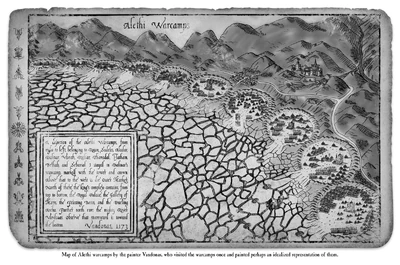
Alethi Warcamps
Drawing by Isaac Stewart
A warcamp is the domain of an Alethi highprince, his retainers, his soldiers, and his bridgemen on the Shattered Plains. Each of the ten warcamps is enormous, and all told, there are over a hundred thousand troops in the various Alethi camps. This number doesn't count the civilians present. (A mobile camp attracts camp followers; stationary camps like these on the Shattered Plains bring even more.)[1][2]
Each warcamp fills its own crater* and is filled with an incongruous mix of Soulcast buildings, shanties and tents. Even within the crater, the stormwinds can be strong, particularly where the outer wall is low or broken. Some places inside the wall remain completely exposed.[1]
Soldiers from one camp didn't mix with those of another, and one stayed away from another Brightlord's crater unless there was business to be done there.[1]
Whorehouses are common in every camp.[3]
*Shallan thinks that the warcamp craters must have once held people and wonders just who the Natan people of long ago had been.[4]
According to Vandonas, painter of the image:
| “ | A depiction of the Alethi Warcamps, from right to left, belonging to Roion, Sadeas, Aladar, Dalinar, Vamah, Ruthar, Thanadal, Hatham, Bethab, and Sebarial. I stayed in Dalinar's warcamp, marked with the tower and crown. Above that to the west is the Outer Market. North of there, the king's complex contains, from top to bottom, the Royal Palace, the Gallery of Maps, the Feasting Basin, and the Dueling Arena. Further north runs the mighty River Vandonas. Observe that stormward is toward the bottom | ” |
–Vandonas, 1173[5] | ||
Dalinar's warcamp is laid out with blocks of barracks forming a large circle around the lighteyed buildings closer to the center. The market is in the outer ring of camp followers beyond the soldiers.[2]
Everything there is arranged so that as many doorways as possible can point away from the Origin of Storms, streets designed so that they can run east to west and provide a way for winds to blow.[2]
References[]
| |||||||||||||||||
